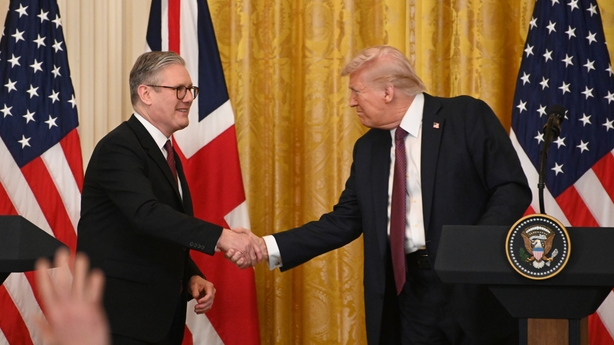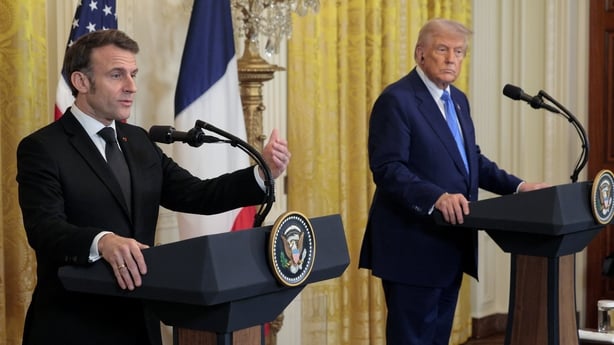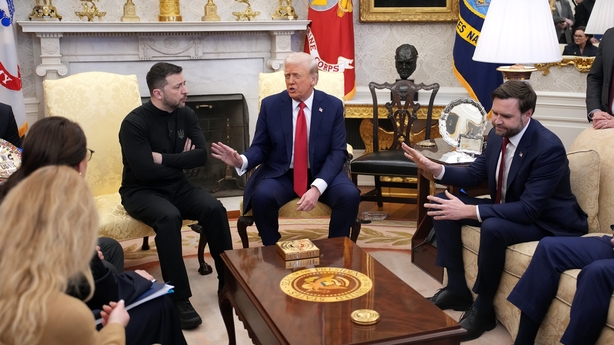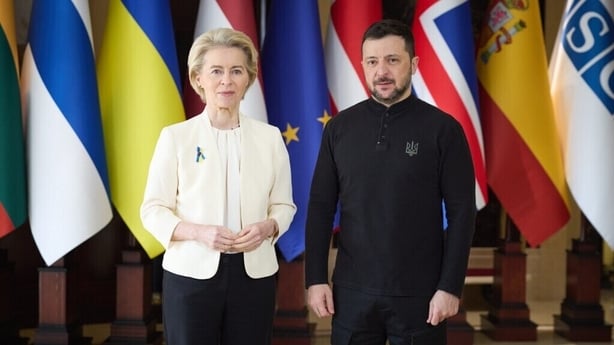It was extraordinary and unprecedented.
US President Donald Trump and Vice President JD Vance's very public clash with Ukrainian President Volodymyr Zelensky in the Oval Office on Friday will go down as one of the most disastrous political press events in modern history.
It looked like a very public ambush and Mr Zelensky took the bait, challenging Mr Vance's assertion that what Ukraine now needed was "diplomacy".
The body language of raised hands from Mr Trump and Mr Vance said it all: they want no part in continuing to help Ukraine fight this war that Russia started.
Mr Trump also made it clear that he has no favourite in the war.
It must have been a shock for Ukraine's president who had been so warmly welcomed by former US president Joe Biden in the same room on his previous visits.
In the space of little more than two weeks, Mr Trump and his vice president have upended the previous Biden administration's rock solid support for Ukraine and brought into question America’s long-standing commitment to Europe.
One can only imagine Russian President Vladimir Putin’s reaction, now emboldened by the Trump administration’s détente with Kremlin officials.
Friday’s verbal clash in the White House also exposes the wide gap that has emerged between Europe and the US over how to end the war in Ukraine.
Reacting to the extraordinary scene in the Oval Office, European leaders rallied to the support of Mr Zelensky, while Mr Trump later berated the Ukrainian president on his Truth Social platform.
Later in London, British Prime Minister Keir Starmer will gather more than a dozen European leaders, including Mr Zelensky, at a summit to discuss the future of European security and Ukraine.
It was supposed to be a chance for Mr Starmer and French President Emmanuel Macron to debrief their fellow leaders on their talks with Mr Trump in Washington earlier in the week.

But Friday's White House row will now likely dominate the agenda and refocus the conversation on how Europe and Ukraine can get the US back on side as a security guarantor for any peace deal with Russia.
Mr Trump, born one year after the end of World War II, harbours little of the transatlantic loyalties that guided the European policy of the 13 other American presidents since 1945.
That’s not to say that this second Trump administration is going to abandon Europe altogether.
Almost 80 years after the end of World War II, America’s military still maintains more than 30 bases across Europe, from Britain to Bulgaria, where it stations over 60,000 military personnel.
However, the new US administration’s sudden détente with Russia - starting with the Trump-Putin phone call, blindsiding the Europeans and Ukraine, and then beginning initial talks with senior Russian officials over ending the war - has jolted European governments into action these past two weeks.
Most European NATO members now spend more than 2% of GDP on defence - meeting the target set by the alliance.
For years, many members, including France and Germany, had failed to meet that target, leaving it to the US to prop up the alliance.
This second Trump administration has made it clear that it expects European countries to spend more on their own defence, and be the majority stakeholder in maintaining the peace in Ukraine.
"It’s just not fair or sustainable," is how US Secretary of State Marco Rubio described the outsized role that the US has played in funding NATO for years in an interview with Fox News this week.
That is all about to change though.

Ever since the Trump administration's reengagement with Russia, European leaders have grasped that they must plan for a scenario in which the continent might have to defend itself in the future.
Conversations started last week when Mr Macron called an emergency summit to decide how to react to American-Russian dialogue on ending the war and to discuss the future of European defence.
The summit in London is a follow up to that first meeting.
At stake are two key security challenges facing the continent, both of which are inextricably linked.
The first is the fate of Ukraine: ensuring Kyiv gets a just peace deal and that Europe takes part in any peace negotiations to end the war.
The price for that involvement, in what now looks like US-brokered peace talks, is that European countries may have to play a central role in any security guarantee for Ukraine, by deploying their own soldiers as peacekeepers to Ukraine after any ceasefire deal.
A plan is emerging for the likely makeup of a peace monitoring or "reassurance force", which could involve up to 30,000 European soldiers.
Unsurprisingly, it has being shaped by the two countries that have led this European wake-up: France and the UK, the only European nuclear powers.

Their leaders have indicated that they would be willing to commit soldiers to a peace monitoring mission in Ukraine.
Denmark, Sweden and Lithuania have also indicated that they would consider contributing troops.
Others, like Germany and Poland, will take more convincing.
The "reassurance force", according to reporting by The Telegraph newspaper, would involve European troops deployed far behind the front lines around the three eastern cities of Poltava, Dnipro and Kryvyi Rih.
"It will be a monitoring mission, mostly using technical sensors and instruments like drones" Mykhailo Samus, a senior Ukrainian defence analyst, told RTÉ News.
The British-French plan envisages that the mission would be supported by an American "backstop" in the form of US fighter jets, stationed in Poland and Romania, ready to deploy in the event that Russia breaks the ceasefire or threatens European troops on the ground.
But again, the extent to which the Trump administration is willing to provide a security guarantee for Ukraine is in jeopardy after Friday's episode in the Oval Office.
Ukrainian and Russian armies would still maintain their ceasefire positions along the frozen front lines, which seems a weak link in the plan.
Not placing a peacekeeping force between the two armies - as risky as it is to deploy - will leave a lot to chance.
Dilemma
If Russia breaks the ceasefire agreement, the European "reassurance force" would then be faced with a dilemma of how to respond, as would the US should it agree to provide the security "back stop" that Ukraine, and Europe requests.
"The problem for Trump is that he will give his word that Putin guaranteed him that he won't attack Ukrainian forces," said Mr Samus, director of the New Geopolitics Research Network, a think tank in Kyiv.
"That's why French and UK forces could just monitor the situation, but not be ready to fight. So this is a very difficult task for Trump."
It is understood that Mr Starmer was supposed to discuss the plan for the European "reassurance force" with Mr Trump when they met in Washington on Thursday.
But no news emerged from the meeting of whether the US would offer the force a security guarantee, which does not bode well.
Without that American "backstop", the odds of deterring Russia would be significantly reduced, and leave Europeans troops in Ukraine - stationed at key Ukrainian infrastructure sites - more open to probing Russian actions.
Despite Friday's fall out in Washington, Ukraine is still seeking that US security guarantee - mineral deal or not - to deter Russia from relaunching its war in the near future.

Of course, Russia this week continued to oppose the deployment of European soldiers as peacekeepers to Ukraine despite Mr Trump claiming that Russian President Vladimir Putin backed the idea.
So the very concept of deploying a European "reassurance force" will be one of the first items on the agenda to be discussed when talks eventually begin.
Taoiseach Micheál Martin has said that Ireland could provide peacekeepers to Ukraine if it was required under a UN-mandated ceasefire agreement.
The second and longer-term security challenge facing Europe is the need to build an independent European defence architecture.
European leaders will look at Russia and know that their governments cannot match anything near the 9% of GDP that the Kremlin spends on its military each year.
Mr Macron has long championed the idea of Europe having greater autonomy from the US on defence.
The UK is also now more on board with this concept but will not want to jeopardise its "special relationship" with the US. Its nuclear doctrine is entirely integrated with the US.
Germany, under the chancellorship of Olaf Scholz, pursued a policy of delivering important armaments to Ukraine in lockstep with the US, or after the Biden administration had acted.
'Independence from the USA'
That is set to change under the next chancellor, Friedrich Merz, leader of the centre-right CDU-CSU alliance.
Though he is a committed transatlanticist, Mr Merz has said his first priority is European security and making sure that Europe "achieves independence from the USA".
They were bold words from a German leader who wants Europe to build its own independent defence capability.
He has also called for discussions with the UK and France on whether their nuclear security could apply to Germany.
"Both Merz and Scholz firmly support Ukraine and advocate for a stronger EU-led security architecture," Sebastian Bollien, an analyst at the German Federal Academy for Security Policy, told RTÉ News.
"A key difference being that Merz has shown that he is more closely aligned with the French perspective on the contingency of a US withdrawal from Europe," he said.
To achieve the kind of security independence from the US that Mr Merz speaks about, Europe is going to have to spend big.
The European Commission has estimated that the EU will need to invest at least €500 billion in defence over the next decade.
An immediate task facing Europe is the need to rearm quickly because a lot of European countries have sent their newest armaments (as well as old hardware) to Ukraine.

EU governments do not have that kind of extra money lying around and high tax increases is not an option many would contemplate either. So the only viable option will be to borrow.
As it stands, the European Investment Bank (EIB) is not allowed to finance the production of weapons, military hardware or ammunition.
However, that could soon change given the current sense of urgency to boost defence spending.
Nineteen EU member states, including France and Germany, recently called on the EIB to increase its lending for Europe's defence industry.
An initial discussion on different funding mechanisms could take place at next Thursday's special EU leaders summit on defence and Ukraine.
Mr Zelensky has also been invited to the summit by António Costa, President of the European Council, another signal that the EU sees Ukraine's future as inseparable from the continent's long-term security plans.
Europe, as a whole, understands that the time has come to become more independent from the US on defence.
But the idea of losing a US security guarantee altogether, whether to uphold a future peace agreement in Ukraine or, to protect the continent as a whole from Russian threats, is still something Europe's leaders will want to avoid.
After Friday's unprecedented clash in the White House, European leaders face a fine balancing act to maintain support for Mr Zelensky and Ukraine while not pushing the Trump administration to jettison Europe altogether.
"The challenge in my eye is what future role the US sees for itself in Europe's defence architecture," said Mr Bollien.







